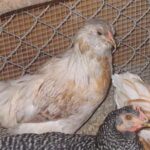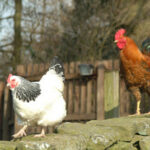Backyard chickens are rising in popularity around the United States, but what about backyard ducks? There are several reasons to consider adding a few ducks to your backyard flock. Not only are they adorable and fun to watch, they also happen to lay large eggs regularly. Duck eggs said to be wonderful for baking, resulting in fluffy cakes and baked goods. They are also often a second choice for those who are allergic to chicken eggs. Duck eggs are very similar in flavor to chicken eggs, someone unsuspecting might not even realize they aren’t being served scrambled eggs from a chicken! Ducks make enjoyable pets and they are hardy animals which makes them somewhat easy to keep.
If you want ducks that are friendly pets, it’s best to start with ducklings. Baby ducks follow their owners around as if following a mama duck. This makes for hours of fun. You can even take your ducklings for a walk down the street! As ducks mature some become less friendly, but others remain as faithful as a dog.
Preparing for baby ducklings is simple. They feather out faster than baby chicks, but they still require a warm heat light for the first few weeks of life. You will want to set up a brooder area for your ducks someplace out of a draft. Ducklings are very messy creatures, keep this in mind when selecting your brooding spot! Since ducks have no anal sphincter, their poop is liquid and can create a situation resembling a muddy patch of ground very quickly. Ducklings also naturally love water and tend to spill it everywhere, soaking the brooding area.
One option for brooding ducklings is a plastic baby pool. (Do not get an inflatable pool, as ducks do have sharp nails and they will pop it quickly.) A plastic pool can be taken out and hosed down frequently to remove spilled water and poop. Pine shavings are a perfect nest for baby ducklings. Make the shavings deeper than you would for chicks, at least several inches, to absorb waste and plan on changing them often! It’s best to keep their watering dish out of the area with shavings since they are likely to fling water everywhere and immediately soak fresh bedding. Be careful ducklings aren’t on a bare slippery surface, as they can slip and break their legs.
Most feed stores sell metal heat lamps that can be clipped on to something or suspended from a ceiling beam. A 250 watt red heat bulb works best, as this does not interrupt the natural daylight and sleep cycle of the ducks. Ducklings require a temperature of 90-100 degrees for the first week or so, then it can be lowered by 5-10 degrees a week. By a month old ducklings need very little heat. (If you are brooding them in the winter, they may require a longer time under the heat lamp.) Be sure to provide enough space so that the ducklings can snuggle under the heat lamp and are still able to move away to a cooler area. Ducks can overheat very fast, and this often means death.
Ducklings require food and water, of course. The best waterer for ducklings is the same kind you would use for adult chickens. You should buy a type of waterer that has enough space for them to dip their wide bills in to drink, but not enough space for them to try and swim! Ducks can also be trained to drink from a rabbit or hamster style hanging bottle with a metal ball in the tip, but they prefer a bowl of some sort.
Ducklings can eat out of a variety of food dishes. They require enough space to scoop up the food with their bills, so a narrow style feeder used for baby chicks will not work. Once the ducks grow a bit larger, by four weeks old, a small litter box makes a simple feeder. Ducklings can eat chick feed for their main diet, however do not purchase medicated chick feed. The amprolium in medicated feed will kill ducks.
In addition to drinking water, ducklings also require a small deep water source that is just large enough to dip their heads into. Ducks need to be able to blow dust and debris out of their nostrils. It’s fun to watch them dip their bills under water and snort. They also enjoy using this water to groom themselves. Despite their messy poop, ducks keep their feathers clean and spend quite a bit of time grooming themselves. Some suggestions for a bill dipping water source are a plastic gallon milk jug with a head sized whole cut in the side or a tall plastic container (yogurt or cottage cheese tub) wired to the side of their brooder cage or pool so that they cannot tip it over.
Ducklings love to swim! When they are very small they tire out quickly and get cold. Always supervise new ducklings closely when swimming to make sure they have the hang of things and they don’t get exhausted and drown. Their down isn’t waterproof like adult feathers, so they can become water logged. Baby ducks love to swim in your bathtub or kitchen sink in luke warm water. Just be prepared to disinfect it afterward, they poop while they swim! For fun and encouragement you can toss frozen peas into the water. Ducklings love to dive under and eat them while they swim.
As they grow up and fully feather out and leave the brooder, you can set up a large plastic baby pool with a ramp for them to swim in as they please. It will need to be emptied every few days because the water quickly turns brown. During the summer heat it can get smelly very fast. The easiest way to empty a plastic baby pool full of duck water is to get a board, put it up against the edge of the pool, and then step on it so that the side bends down and the water drains out.
Adult ducks can be housed in the same coop as chickens as long as they have space to make a nest in the corner. Ducks need a predator-proof coop just like chickens do, and with a little effort you can train them to go into their coops every night along with the chickens. A pair of ducks can also fit in a large dog house as long as it’s fitted to lock up tight at night. If you have a large pond, ducks will sleep out on the pond where predators cannot reach them at night.
There are many fun breeds of ducks to choose from. One of the most popular type of ducks is the Pekin duck. These ducks are completely domesticated and very friendly. They are unable to fly, which makes them ideal for a backyard setting. Pekins are also relatively cold hardy, surviving fine in temperatures around 10 degrees below freezing as long as they have food, water, and draft-free shelter. If you purchase a wild breed of duck, like the Mallard, be prepared for them to attempt to join wild duck flocks and migrate!
It is possible to sex your ducklings by the sound of their quack once they are past the first few weeks of life. Male ducks have a low quiet quack while female ducks are very loud and almost seem to honk at times. Once male ducks mature they grow a drake feather on their tail. This is one lone feather in the middle of the tail that curls up towards their head. Some breeds of ducks have different color patterns for males and females, such as the Mallard, which makes them easy to sex as soon as their adult feathers start to grow in.
Raising ducklings is a great experience for a family. They are easy to care for, entertaining, loving, and you’ll enjoy the reward of large delicious eggs!



